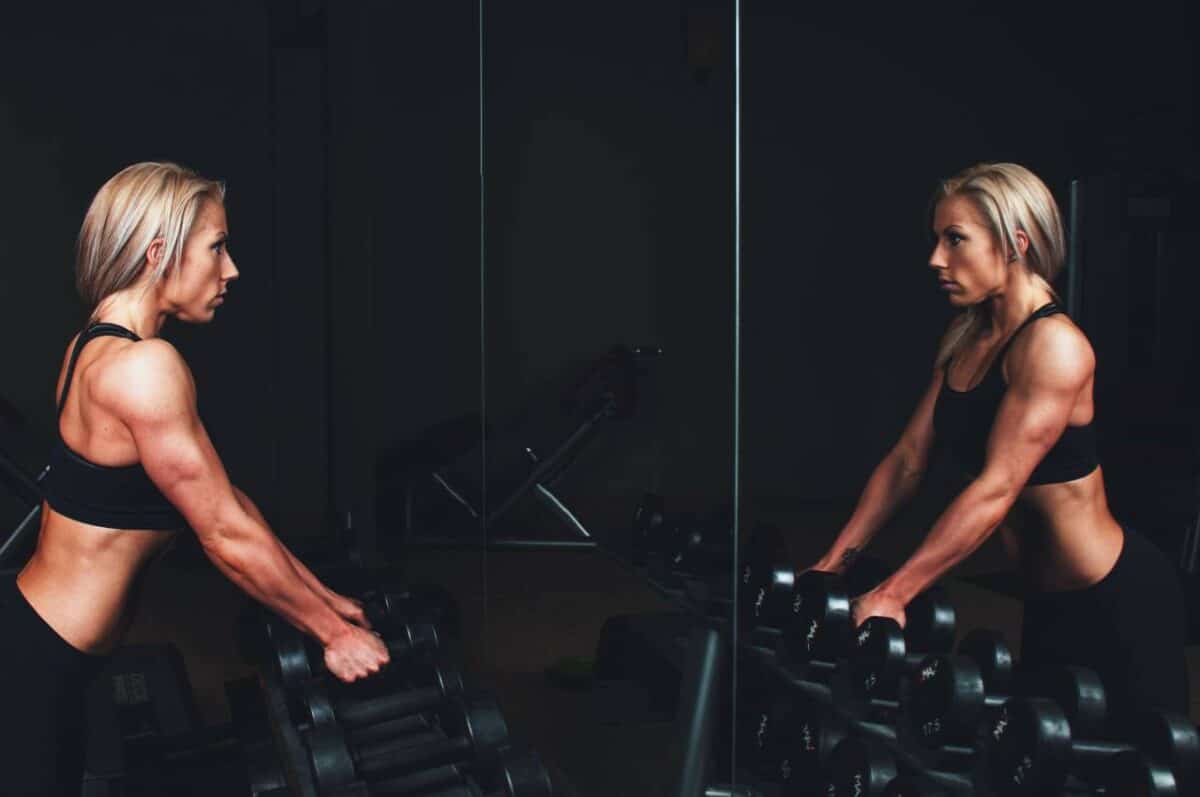In this article, we will show 3 exercises for the triceps with dumbbells.
Additionally, we will analyze what aspects need to be considered when selecting exercises for our training programs.
Anatomy of the triceps brachii
Before analyzing the exercises for triceps with dumbbells, we will anatomically contextualize the triceps. The triceps brachii is a muscle that has 3 points of origin: the medial head, the lateral head, and the long head (11). It is important to note that the long head of the triceps is biarticular (11). The heads of the triceps are also known as the internal, external, and middle or long vastus (11). The triceps brachii is located on the posterior side of the arm and, being a large muscle, it occupies a large part of it (11).
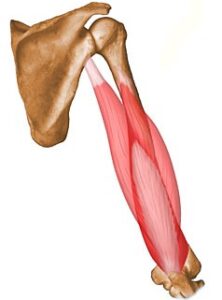
Being a biarticular muscle, the triceps brachii acts on the elbow and the shoulder (11):
- At the elbow level: it extends the forearm over the arm.
- At the shoulder level: it extends the shoulder and is an accessory adductor when the shoulder is in extension.
The anatomical and biomechanical characteristics of this muscle make it participate in climbing or pulling (11).
Considering the shoulder and elbow joint, the moment when the triceps would have the greatest mechanical advantage is with a slight shoulder flexion and a moderate elbow flexion (11).
En este curso vamos a tratar el entrenamiento de la fuerza orientada a la hipertrofia muscular, buscando las formas de optimizar el proceso a la hora de planificar las cargas y las sesiones de entrenamiento.
Aprenderemos a determinar cuándo nos interesa conseguir esa hipertrofia, cómo esta afecta a los niveles de fuerza y la importancia de conocer el estado inicial de la persona que se someta a este tipo de entrenamiento.
What are the best exercises to train triceps with dumbbells?
In the following section, we will explain in detail the 3 exercises for the triceps with dumbbells.
Dumbbell French press
This is the first of the best triceps exercises with dumbbells, which we analyze below:
Starting position
The starting position for executing this exercise will be lying supine on a horizontal plane with a dumbbell in each hand (4).
Execution phase
- Inhale and flex the elbows controlling the movement.
- Return to the starting position and exhale at the end of the effort.
This exercise for the triceps with dumbbells allows for equal engagement of the three portions of the muscle (4).
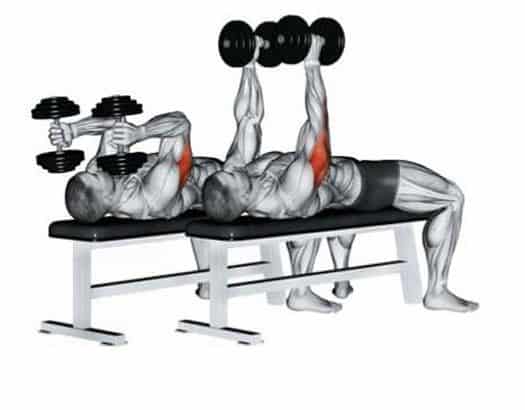
Unilateral dumbbell French press
It is also possible to perform this exercise for the triceps with dumbbells in a unilateral manner (4).
This means that during the execution of the exercise, we will only use 1 dumbbell and only one of the arms will be working (4).
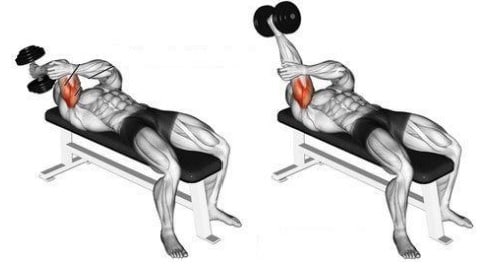
One of the main benefits of performing exercises unilaterally is that we ensure both arms receive the same stimulus (4).
On the other hand, when we perform an exercise bilaterally, depending on the person, compensations can occur that may cause one limb to work more than the other (4).
Standing overhead elbow extension
Next, we analyze the second of the best triceps exercises with dumbbells.
Starting position
We will start the exercise standing, with the dumbbell held in one hand, with a shoulder flexion of 180º and with the humerus perpendicular to the ground (4).
Execution phase
- Inhale and perform an elbow flexion until the dumbbell is behind the neck.
- Return to the starting position and exhale at the end of the movement.
The vertical position of the arm stretches the long head of the triceps, thus favoring its contraction during the work (4).
This exercise for the triceps with dumbbells will require proper core activation and lumbopelvic stability to provide stability to our torso (4).
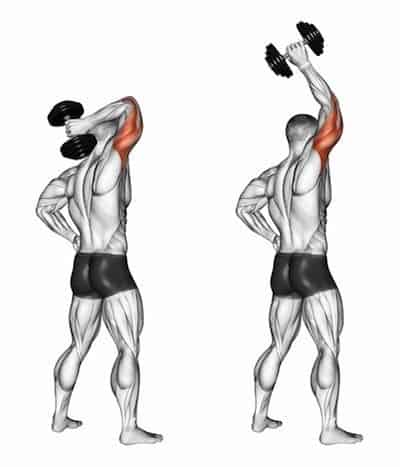
Seated elbow extension with a dumbbell
Next, we analyze the execution of this exercise for triceps with a dumbbell.
Starting position
We will start the exercise seated with the dumbbell held with both hands behind the neck (4).
Execution phase
- Inhale and perform an elbow extension.
- Exhale at the end of the movement.
The vertical position of the arm strongly stretches the long portion of the triceps brachii, favoring a good engagement of this region during its contraction (4).
In this exercise for the triceps with dumbbells, it is important to contract the core muscles to avoid excessively curving the back, and whenever possible, it is recommended to use a bench with a short backrest (4).
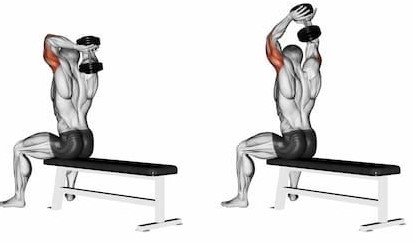
Effects of shoulder position in exercises for the triceps with dumbbells
Previously, we mentioned 3 exercises for the triceps with dumbbells.
However, a series of factors must be considered to select one or the other when introducing them into our training programs.Therefore, we must consider the mechanical characteristics of the exercise, such as the resistance profile, movement speed, instability conditions, the kinetic chain, the range of motion (ROM), and the different postures that can be adopted during the execution of an exercise (2, 5, 7, 8, 10 12, 13, 14, 10).
The postural variation in an exercise is a way to obtain different activation patterns of the muscles, and consequently emphasize different regions of the muscle (7, 10).
It is worth noting, as we mentioned earlier, that the long head of the triceps is biarticular and acts on the scapula and the elbow. In contrast, the short and medial heads act only on the elbow (3).
The exercises for the triceps with dumbbells analyzed are the bilateral French press and the seated elbow extension.
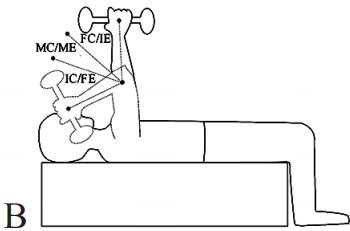
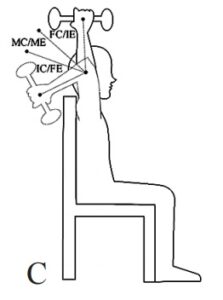
Analyzed ROM’s: IC = start of concentric phase, FE = end of eccentric phase, MC = mid-range of concentric phase, ME = mid-range of eccentric phase, FC = end of concentric phase, IE = start of eccentric phase.
In this analysis, we will observe the activation of the long head of the triceps and the activation of the lateral head in the different ranges of motion during the concentric and eccentric phases of the two exercises for the triceps with dumbbells mentioned.
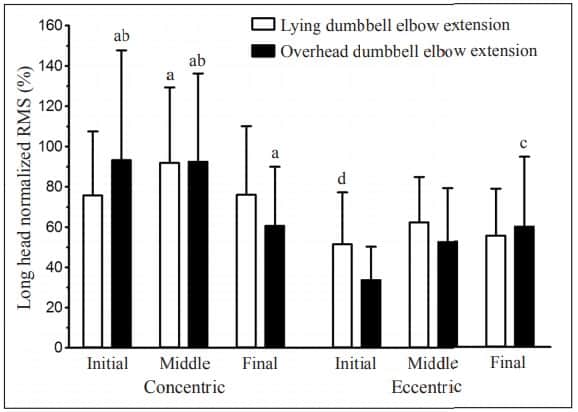
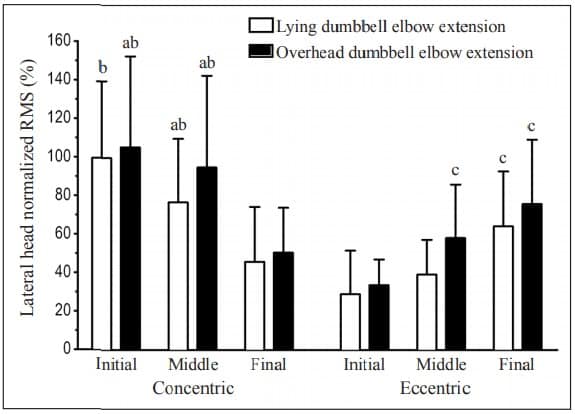
As we can see in both graphs, during the concentric phase of this exercise for triceps with dumbbells, a greater muscle activation of both heads is achieved, mainly of the long head (1).
During the concentric phase of the two exercises for triceps with dumbbells, in the initial and mid ROM, a greater activation of the triceps is obtained than in the final ROM, especially for the lateral head (1).
The least muscle activation is observed in the eccentric phase of the two exercises (1).
The maximum force produced by the triceps while shortening (concentric contraction) is less than when stretching (eccentric contraction) (6, 9).
In the concentric and eccentric phases, muscle activation is lower when the elbow is near full extension, where the moment arm is smaller (1).
The main difference between these exercises for the triceps with dumbbells can be observed in the stretching of the long head of the triceps (1).
The shoulder position during the execution of the overhead elbow extension causes the long head of the triceps to be in its maximum range of stretch.
Therefore, it is more stretched than in the dumbbell French press (1).
The fact that the long head is more stretched in the overhead elbow extension exercise is because this portion of the triceps also acts in shoulder movements (1).
Therefore, we observe that the muscle activation of the long head varies between both exercises because it is biarticular, and a greater shoulder flexion, as in the elbow extension with a dumbbell, causes a greater activation of that portion of the triceps brachii (1).
However, as we can see in the graphs, there are no significant differences between the studied exercises regarding the muscle activation of the lateral head of the triceps.
Being this portion uniarticular, the shoulder position does not influence its activation pattern (1).
Conclusions
In this article, we analyzed the best exercises to train the triceps with dumbbells. They are undoubtedly ideal exercises for building strong triceps.
The shoulder position in exercises for the triceps with dumbbells will be decisive for whether there is less or greater activation of the long head of the triceps.
If we want to emphasize the muscle activation of the long head of the triceps, we will perform exercises where the shoulder is as flexed as possible.
Some examples are those exercises where the dumbbell passes over the head.
In conclusion, when selecting exercises for the triceps, we will observe the shoulder position during execution to work more on one portion of the triceps or another.
Podcast “3 exercises for triceps”: Play in new window |
Subscribe to Apple Podcasts | Spotify | Google Podcasts |
Bibliographic references
- Alves, D., Matta, T., & Oliveira, L. (2018). Effect of shoulder position on triceps brachii heads activity in dumbbell elbow extension exercises. The Journal of sports medicine and physical fitness, 58(9), 1247–1252. https://doi.org/10.23736/S0022-4707.17.06849-9.
- Calatayud J, Borreani S, Colado JC, Martín FF, Rogers ME, Behm DG, et al. (2014). Muscle activation during push-ups with different suspension training systems. J Sports Sci Med, 13:502-10.
- Davidson, A. W., & Rice, C. L. (2010). Effect of shoulder angle on the activation pattern of the elbow extensors during a submaximal isometric fatiguing contraction. Muscle & nerve, 42(4), 514–521. https://doi.org/10.1002/mus.21717
- Delavier, F. (2018). Strength training anatomy (6th edition). Editorial Paidotribo.
- Ebben, W. P., & Jensen, R. L. (2002). Electromyographic and kinetic analysis of traditional, chain, and elastic band squats. Journal of strength and conditioning research, 16(4), 547–550.
- Enoka R. M. (1996). Eccentric contractions require unique activation strategies by the nervous system. Journal of applied physiology (Bethesda, Md. : 1985), 81(6), 2339–2346. https://doi.org/10.1152/jappl.1996.81.6.2339
- Kasprisin, J. E., & Grabiner, M. D. (2000). Joint angle-dependence of elbow flexor activation levels during isometric and isokinetic maximum voluntary contractions. Clinical biomechanics (Bristol, Avon), 15(10), 743–749. https://doi.org/10.1016/s0268-0033(00)00036-x
- Koyama, Y., Kobayashi, H., Suzuki, S., & Enoka, R. M. (2010). Enhancing the weight training experience: a comparison of limb kinematics and EMG activity on three machines. European journal of applied physiology, 109(5), 789–801. https://doi.org/10.1007/s00421-010-1421-y
- Lieber, R. L., & Fridén, J. (2000). Functional and clinical significance of skeletal muscle architecture. Muscle & nerve, 23(11), 1647–1666. https://doi.org/10.1002/1097-4598(200011)23:11<1647::aid-mus1>3.0.co;2-m
- Maffiuletti, N. A., & Lepers, R. (2003). Quadriceps femoris torque and EMG activity in seated versus supine position. Medicine and science in sports and exercise, 35(9), 1511–1516. https://doi.org/10.1249/01.MSS.0000084426.03247.93
- Triceps brachii muscle [September 8, 2021]. https://www.ugr.es/~dlcruz/musculos/musculos/triceps%20braquial.htm
- Naczk M, Naczk A, Brzenczek-Owczarzak W, Arlet J, Adach Z (2016). Efficacy of inertial training in elbow joint muscles: influence of different movement velocities. J Sports Med Phys Fitness, 56:223-31.
- Paoli, A., Marcolin, G., & Petrone, N. (2010). Influence of different ranges of motion on selective recruitment of shoulder muscles in the sitting military press: an electromyographic study. Journal of strength and conditioning research, 24(6), 1578–1583. https://doi.org/10.1519/JSC.0b013e3181d756ea
- Stensdotter, A. K., Hodges, P. W., Mellor, R., Sundelin, G., & Häger-Ross, C. (2003). Quadriceps activation in closed and in open kinetic chain exercise. Medicine and science in sports and exercise, 35(12), 2043–2047.
